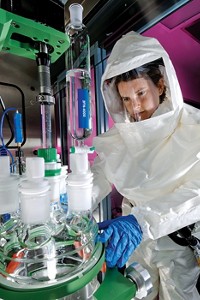Advertisement
Grab your lab coat. Let's get started
Welcome!
Welcome!
Create an account below to get 6 C&EN articles per month, receive newsletters and more - all free.
It seems this is your first time logging in online. Please enter the following information to continue.
As an ACS member you automatically get access to this site. All we need is few more details to create your reading experience.
Not you? Sign in with a different account.
Not you? Sign in with a different account.
ERROR 1
ERROR 1
ERROR 2
ERROR 2
ERROR 2
ERROR 2
ERROR 2
Password and Confirm password must match.
If you have an ACS member number, please enter it here so we can link this account to your membership. (optional)
ERROR 2
ACS values your privacy. By submitting your information, you are gaining access to C&EN and subscribing to our weekly newsletter. We use the information you provide to make your reading experience better, and we will never sell your data to third party members.
Pharmaceuticals
Helping Tie Up A Peptide Drug’s Loose Ends
Case Study #1: Ironwood works with peptide makers and others to turn its cross-linked molecule into a drug
by Ann M. Thayer
March 4, 2013
| A version of this story appeared in
Volume 91, Issue 9

Of the 39 new drugs the Food & Drug Administration approved in 2012, six were peptidelike, the largest single drug group after small molecules. One member of this group stood out because of an unusual attribute: It is a pill.
Almost all peptide drugs approved so far must be injected, otherwise a patient’s gastrointestinal tract would eat up these amino acid chains. But with linaclotide, Cambridge, Mass.-based Ironwood Pharmaceuticals succeeded in making an orally administered polypeptide drug, which it sells as Linzess in the U.S. and will be sold as Constella in Europe to treat bowel disease.
And Ironwood didn’t have to modify the peptide chemically or use a special delivery method. Instead, it benefited from a fortuitous combination of its drug’s structure, behavior, and disease target.
The 14-year-old firm was also fortunate to have the help of manufacturing, formulation, and commercial partners. The development of linaclotide occurred while Ironwood itself was evolving, says Bill Kissel, the firm’s director of technical operations. “It has been quite a journey for us, and it would not have been possible without very, very strong collaborations,” he says.
The company was founded in 1998 as Microbia to engineer chemical-producing microbes. By the early 2000s it had shifted focus to pharmaceuticals. Over the past decade, it has raised hundreds of millions of dollars from private and public investors and from big pharma development partners. It took the Ironwood name in 2008 and sold the microbe engineering business to DSM in 2010.
Linaclotide emerged from the company’s own labs. It is structurally similar to natural hormones that R&D President Mark G. Currie discovered while studying the guanylate cyclase-C pathway. By activating GC-C on intestinal surfaces, these hormones initiate a process that increases fluid secretion and transit through the intestine and may help ease pain.
Because linaclotide acts as a signal in this process, Ironwood saw it as a treatment for chronic idiopathic constipation and irritable bowel syndrome with constipation in adults. In the U.S., as many as 35 million people suffer from the first problem and another 13 million from the second. Linaclotide was the first, and to date only, GC-C agonist approved in the U.S., according to the firm. Before the approval, physicians had few therapies to offer these patients other than standard over-the-counter remedies. By 2021, the drug could have annual sales of $1.2 billion, predicts the market research firm Decision Resources.
Linaclotide’s unique three-dimensional structure “gives the molecule certain thermal and metabolic stability that is unusual for a peptide,” says Angelika Fretzen, Ironwood’s vice president for pharmaceutical chemistry and development. The polypeptide consists of 14 natural amino acids, six of which are cysteines that pair to form three disulfide bridges. The result is a multicyclic knot that can resist enzymatic degradation in the gut.
For early studies, the company used its in-house expertise to make variants of the peptide recombinantly rather than through chemical synthesis, Fretzen explains. Synthesis became the pragmatic approach. “When we started to see there was something interesting that we wanted to take forward into the clinic, we approached manufacturers to get the needed amounts.”
Synthesizing a tightly bound polypeptide can be challenging, but over the past 30 years peptide synthesis and purification have matured. A turning point came in 2003 when Roche launched its HIV drug Fuzeon, a then-unheard-of 36-amino-acid-long polypeptide that Roche succeeded in making via solid-phase synthesis.
“The whole peptide manufacturing world had undergone a shift to commercial feasibility, and so it was the right way to go,” Fretzen says about choosing the synthetic route.
Today, Ironwood has commercial supply agreements with two peptide manufacturers. One is PolyPeptide Laboratories, working through its Torrance, Calif., and Malmö, Sweden, locations. The other is Corden Pharma Colorado, the former Roche peptide manufacturing operation, which Roche sold to investors in 2011.
Linaclotide’s linear sequence shows that “it is a short peptide and easily amenable to solid-phase peptide synthesis. It also is designed to fold into the active form,” Kissel says. “Where you start getting into the complexities is in purifying the active folded form.”

Any peptide synthesis can be complicated by unwanted by-products generated through racemization along the amino acid chain. Amino acids that cross-link open up the door to polymeric side products as well, notes Rodney Lax, PolyPeptide’s senior director of business development for North America. And with multiple cysteines, the trick becomes linking up the correct pairs to generate the desired cyclic structure rather than any of the many possible wrong combinations.
Some cyclic peptides will fold naturally into the right configuration. For these, Lax explains, the chemist may be able to use one type of protecting group to shield all the cysteines until it’s time to expose them and cyclize the chain. If a polypeptide needs help to fold properly, the chemist may use different sets of protecting-group chemistries and then remove the groups stepwise to link up select pairs.
Not only is the overall large-scale synthesis of a multicyclic peptide complex, but as for any peptide, the impurities that researchers must characterize and track are often very similar to the desired product. Exactly how each peptide manufacturer achieves the desired product and purity depends on its in-house know-how. As a result, their production processes often differ slightly, and they hold the details close.
That’s why it’s important to ensure that products from different manufacturers are comparable, Kissel explains. “We had to build up robust technologies for evaluating the purity, quality, and physical properties of the material from different sources,” he says. “Whereas they are experts in peptide manufacturing, no one understands linaclotide better than Ironwood, and so we truly partnered on the analytical method development.”
Another challenge in peptide drug development is stabilizing the product for storage at ambient temperatures. To find a stable solid oral dossage form with the desired shelf life, Ironwood worked on formulation alone and with outside partners, Fretzen says.
“We had to learn a lot about this peptide and potential degradation pathways to understand how we can stabilize it, and again the analytical technologies played a big role in that,” she says. Stability was achieved by selecting the best combination of formulation aids, or excipients, in the final capsules.
Others attempting to create oral peptide drugs have added enhancers to increase permeability across membranes and improve cellular uptake to reach the disease target. Ironwood didn’t have to do that. Linaclotide targets extracellular receptors on the surface of the intestine, and the drug is minimally absorbed when ingested. “It acts locally, and so that actually allows us to dose it as an oral form,” Fretzen says.
Beyond manufacturing, other partnerships have been critical to moving linaclotide through development. In 2007, Ironwood entered a $330 million pact with New York City-based Forest Laboratories to jointly develop and sell Linzess in North America. In 2009, Spain’s Almirall set up a $95 million deal to be Ironwood’s European partner, and Japan’s Astellas Pharma signed on for $75 million to cover many Asian countries. In late 2012, AstraZeneca agreed to pay $150 million to codevelop and help sell the drug in China.
Ironwood’s three commercial partners are responsible for manufacturing the final drug product. Outside the regions covered by these partners, Ironwood works with Northern Ireland’s Almac Pharma Services to make the final product.
Ironwood has composition-of-matter patents protecting the drug that last until 2025, and it hopes to see others granted on product formulations. With the help of many development, manufacturing, and commercial partners, the company has evolved into a full-fledged pharmaceutical firm. It now looks forward to building a business around its first, potentially blockbuster, product.




Join the conversation
Contact the reporter
Submit a Letter to the Editor for publication
Engage with us on Twitter